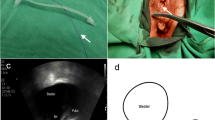Abstract
Objectives
The transobturator mid-urethral Altis® “mini-sling” uses a static and a dynamic anchor on either end of a pulley suture for intraoperative tension adjustment. Given the potential for incorrect tensioning with sling placement, we adopted a modification for post-operative adjustment should stress urinary incontinence (SUI) persist. The objective is to describe technique, rate of postoperative adjustment driven by patient symptoms, and impact of preoperative/intraoperative variables.
Methods
In this single-surgeon experience, retrospective chart review, demographic and clinical data were collected on patients who received the Altis® sling for SUI between 2014 and 2019. We used descriptive statistics and three-group comparison tests to assess difference in variables among tightening, loosening, or no adjustment.
Results
Altis® sling placement was performed on 197 female patients with an average age of 58.7 years. Eighty-four percent (165/197) did not receive post-operative adjustment. Of the 32 patients with post-operative adjustment, 8 (4.1%) had loosening and 24 (12.2%) had tightening at an average of 10.5 days post-operatively. All tightening procedures were done in the clinic. Of the 8 patients with post-operative loosening, 6 were performed in clinic and 2 in the operating room. Preoperative and intraoperative variables were not significantly different among tightening, loosening, and no adjustment cohorts.
Conclusions
This modification of the Altis® sling provides surgeons with the ability to tighten and loosen the sling for persistent SUI. All tightening and most loosening procedures were able to be performed in the clinic. The ability to easily tighten a sling in the early post-operative period may be a critical advantage.

Similar content being viewed by others
References
Abrams P, Cardozo L, Fall M, Griffiths D, Rosier P, Ulmsten U, Van Kerrebroeck P, Victor A, Wein A (2003) Standardisation Sub-Committee of the International Continence Society, The standardisation of terminology in lower urinary tract function: report from the standardisation sub-committee of the International Continence Society. Urology 61:37–49. https://doi.org/10.1016/s0090-4295(02)02243-4
Hampel C, Wienhold D, Benken N, Eggersmann C, Thüroff JW (1997) Definition of overactive bladder and epidemiology of urinary incontinence. Urology 50:4–14. https://doi.org/10.1016/s0090-4295(97)00578-5
Rogers RG (2008) Clinical practice. Urinary stress incontinence in women. N Engl J Med 358:1029–1036. https://doi.org/10.1056/NEJMcp0707023
Abrams P, Andersson KE, Birder L, Brubaker L, Cardozo L, Chapple C, Cottenden A, Davila W, de Ridder D, Dmochowski R, Drake M, Dubeau C, Fry C, Hanno P, Smith JH, Herschorn S, Hosker G, Kelleher C, Koelbl H, Khoury S, Madoff R, Milsom I, Moore K, Newman D, Nitti V, Norton C, Nygaard I, Payne C, Smith A, Staskin D, Tekgul S, Thuroff J, Tubaro A, Vodusek D, Wein A, Wyndaele JJ (2010) Members of committees, fourth international consultation on incontinence, fourth international consultation on incontinence recommendations of the international scientific committee: evaluation and treatment of urinary incontinence, pelvic organ prolapse, and fecal incontinence. Neurourol Urodyn 29:213–240. https://doi.org/10.1002/nau.20870
Rapp DE, Kobashi KC (2008) The evolution of midurethral slings. Nat Clin Pract Urol 5:194–201. https://doi.org/10.1038/ncpuro1052
Lee Y-S, Lee HN, Lee K-S (2010) The evolution of surgical treatment for female stress urinary incontinence: era of mid-urethral slings, Korean. J Urol 51:223–232. https://doi.org/10.4111/kju.2010.51.4.223
Kocjancic E, Erickson T, Tu L-M, Gheiler E, Van Drie D (2017) Two-year outcomes for the Altis ® adjustable single incision sling system for treatment of stress urinary incontinence. Neurourol Urodyn 36:1582–1587. https://doi.org/10.1002/nau.23156
D’alessandro G, Leone M, Antolini J, Ferrero S, Sala P, Melloni G, Fasolis G, Gustavino C (2020) Three-year follow-up in patients with urinary stress incontinence treated with Altis® single-incision sling. Minerva Ginecol 72:12–18
Ugurlucan FG, Yasa C (2017) Adjustable midurethral slings in the treatment of female stress urinary incontinence. In: Alhasso A, Bekarma H (eds) Synopsis in the management of urinary incontinence. InTech, London. https://doi.org/10.5772/66856
Errando C, Rodriguez-Escovar F, Gutierrez C, Baez C, Araño P, Villavicencio H (2010) A re-adjustable sling for female recurrent stress incontinence and sphincteric deficiency: outcomes and complications in 125 patients using the Remeex sling system. Neurourol Urodyn 29:1429–1432. https://doi.org/10.1002/nau.20879
Mantovani F, Castelnuovo C, Bernardini P (2004) ReMeEx device (External Mechanical Regulator) for incontinence: implantation and regulation procedure, complications and results at 3 years follow-up. Arch Ital Urol Androl 76:49–50
Park BH, Kim JC, Kim HW, Kim YH, Choi JB, Lee DH (2015) Midterm efficacy and complications of readjustable midurethral sling (Remeex system) in female stress urinary incontinence with recurrence or intrinsic sphincter deficiency. Urology 85:79–84. https://doi.org/10.1016/j.urology.2014.10.003
Morán E, Pérez-Ardavín J, Sánchez JV, Bonillo MA, Martínez-Cuenca E, Arlandis S, Broseta E, Boronat F (2019) Mid-term safety and efficacy of the ALTIS® single-incision sling for female stress urinary incontinence: less mesh, same results. BJU Int 123:E51–E56. https://doi.org/10.1111/bju.14569
Araco F, Gravante G, Dati S, Bulzomi V, Sesti F, Piccione E (2008) Results 1 year after the Reemex system was applied for the treatment of stress urinary incontinence caused by intrinsic sphincter deficiency. Int Urogynecol J Pelvic Floor Dysfunct 19:783–786. https://doi.org/10.1007/s00192-007-0523-5
Funding
None.
Author information
Authors and Affiliations
Corresponding author
Additional information
Publisher's Note
Springer Nature remains neutral with regard to jurisdictional claims in published maps and institutional affiliations.
Rights and permissions
About this article
Cite this article
Friedman, B.J., Nguyen, J., Vollstedt, A. et al. A modified Altis® mid-urethral sling that allows immediate post-operative adjustment: experience in 197 patients. Int Urol Nephrol 54, 241–247 (2022). https://doi.org/10.1007/s11255-021-03081-5
Received:
Accepted:
Published:
Issue Date:
DOI: https://doi.org/10.1007/s11255-021-03081-5




